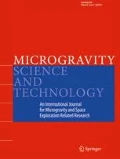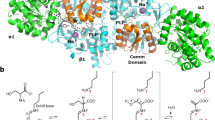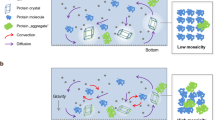Abstract
For the purpose of bio-electronics, bacteriorhodopsin was crystallized into two habits through liquid-liquid-diffusion, namely individual needles of up to 1.9 mm in length and needle bunch-like clusters of up to 4.9 mm in total length. In both the reduced gravity experiments performed, the morphology of the individual needles (crystal form A) had improved in terms of sharp needle edges and compact needle packing, compared to the parallel ground controls. For the long duration wide range low gravity condition in the "Diffusion-controlled Crystallization Apparatus for Microgravity (DCAM)" on Mir (STS-89 up), needle bunches on average were longer there than on the ground, while the compactness of the clusters, i.e. the average ratio of clustered length to clustered width was the reverse. Some exceptionally large individual needles were grown in DCAM. For the "Commercial Protein Crystallization Facility (CPCF)" in short duration high definition microgravity condition during a science mission of the Space Shuttle Discovery (STS-95), size and shape of the individual needles were homogeneous and superior to those of both the parallel ground controls and the results in DCAM. In CPCF, the average volume of the individual needles in suspension was increased by 50 % in microgravity compared to those in the ground control.
Similar content being viewed by others
References
Oesterhelt, D., Bräuchle, C., Hampp, N.: Bacteriorhodopsin: a biological material for information processing. Q. Rev. Biophys., vol. 24, p. 425 (1991).
Hampp, N. A.: Bacteriorhodopsin: mutating a biomaterial into an optoelectronic material. Appl. Microbiol. Biotechnol., vol. 53, p. 633 (2000).
Juchem, T., Hampp, N.: Non-destructive testing system based on bacterior-hodopsin films. 238. WE-Heraeus-Seminar (2000).
Michel, H., Oesterhelt, D.: Three-dimensional crystals of membrane proteins: bacteriorhodopsin. Proc. Natl. Acad. Sci. U.S.A., vol. 77, p. 1283 (1980).
Landau, E. M., Rosenbusch, J. P.: Lipidic cubic phases: a novel concept for the crystallization of membrane proteins. Proc. Natl. Acad. Sci. U.S.A., vol. 93, p. 14532 (1996).
Luecke, H., Schobert, B., Richter, H. T., Cartailler, J. P., Lanyi, J. K.: Structure of bacteriorhodopsin at 1.55 Å, resolution. J. Mol. Biol., vol. 291, p. 899 (1999).
Pebay-Peyroula, E., Rummel, G., Rosenbusch, J. P., Landau, E. M.: X-ray structure of bacterio-rhodopsin at 2.5 angstroms from microcrystals grown in lipidic cubic phases. Science, vol. 277, p. 1676 (1997).
Michel, H.: Characterization and crystal packing of three-dimensional bacteriorhodopsin crystals. EMBO J., vol. 1, p. 1267 (1982).
Wagner, G., andLinhardt, R.: Liquid-liquid diffusion profiles in microgravity experiments, and crystal growth of the membrane protein bacteriorho dopsin. J. Crystal Growth, vol. 110, p. 114 (1991).
Otalora, F., Garcia Ruiz, J. M.: Crystal growth studies in microgravity with the APCF. 1. Computer simulation of transport dynamics. J. Crystal Growth, vol. 182, p. 141 (1997).
Ducruix, A. and Giegé, R.: Crystallization of Nucleic Acids and Proteins, Second Edition, Oxford Univ. Press (1999).
Wagner, G.: Bacteriorhodopsin Crystal Growth under Microgravity Results of IML-1 and Spacehab-1 Experiments. ESA Journal, vol. 18, p. 25 (1994).
Dag, O., Ahari, H., Coombs, N., Jiang, T., Aroca-Ouellette, P. P., Petrov, S., Sokolov, I., Verma, A., Vovk, G., Young, D., Ozin, G. A., Reber, C., Pelletier, Y., Bedard, R. L.: Does microgravity influence self-assembly? Advanced Materials, vol. 9, p. 1133 (1997).
Bosch, R., Lautenschlager, P., Potthast, L., Stapelmann, J.: Experiment equipment for protein crystallization inµg facilities. J. Crystal Growth, vol. 122, p. 310 (1992).
Pletser, V., Stapelmann, J., Potthast, L., Bosch, R.: The protein crystallization diagnostics facility, a new european instrument to investigate biological macromolecular crystal growth on board the international space station. J. Cryst. Growth, vol. 196, p. 638 (1999).
Carter, D. C., et al.: Diffusion-controlled crystallization apparatus for microgravity (DCAM): flight and ground-based applications. J. Crystal Growth, vol. 196, p. 602 (1999).
Schertler, G. F. X.: Kristallisation von Bacteriorhodopsin. Charakterisierung des M-Intermediats im Kristall. Dissertation Universität München (1988), (Wissenschaftl. Forschungsbeiträge Biol., Biochem., Chem. 41).
Michel, H.: Enzymes, Receptors and Carriers of Biological Membranes, in Azzi et al. (Eds.): Crystallization of two membrane proteins: bacteriorhodopsin and photosynthetic reaction centres. Springer-Verlag Berlin, Heidelberg, p. 39 (1984).
Neugebauer, D.-Ch., Zingsheim, H. P., Oesterhelt, D.: Recrystallization of the purple membrane in vivo and in vitro. J. Mol. Biol., vol. 123, p. 247 (1978).
Neugebauer, D.-Ch., Zingsheim, H.-P., Oesterhelt: Biogenesis of purple membrane in halobacteria. Methods in Enzymology, vol. 97, p. 218 (1983).
Schertler, G. F. X., Bartunik, H. D., Michel, H., Oesterhelt, D. J.: Orthorhombic crystal form of bacteriorhodopsin nucleated on benzamidine diffracting to 3.6 Å resolution. Mol. Biol., vol. 234, p. 156 (1993).
Author information
Authors and Affiliations
Corresponding author
Rights and permissions
About this article
Cite this article
Zörb, C., Weisert, A., Stapelmann, J. et al. Bacteriorhodopsin crystal growth in reduced gravity - Results under the conditions, given in CPCF on board of a space shuttle, versus the conditions, given in DCAM on board of the Space Station Mir. Microgravity sci. Technol. 13, 22 (2002). https://doi.org/10.1007/BF02872073
Received:
Revised:
Accepted:
DOI: https://doi.org/10.1007/BF02872073




